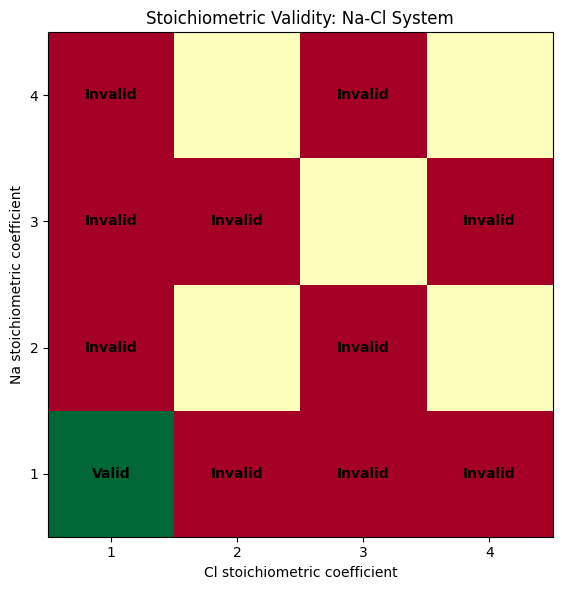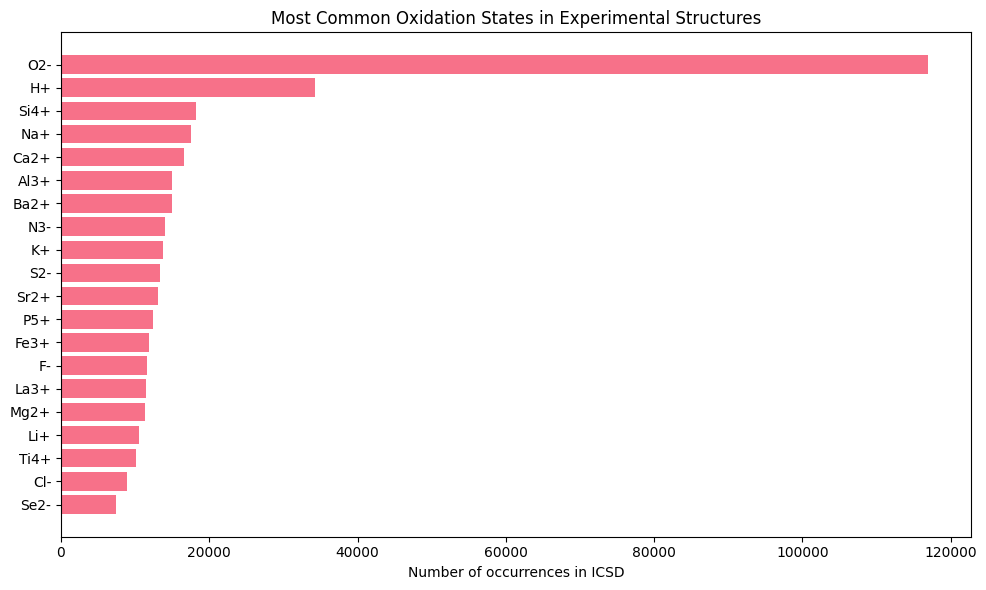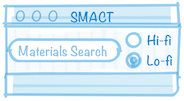Stoichiometry Screening: Getting the Ratios Right#
You’ve mastered chemical filters and compositional screening - now it’s time to tackle a more focused challenge: finding the right atomic ratios. Once you know which elements to combine, how do you determine the optimal stoichiometry?
This tutorial will teach you to systematically explore stoichiometric spaces and identify chemically viable atomic ratios using SMACT.
What You’ll Learn#
Distinguish compositional from stoichiometric screening
Generate systematic stoichiometric spaces for element combinations
Apply chemical validation rules to atomic ratios
Screen specific structure types (binary, perovskite, quaternary)
Use ICSD occurrence data to guide predictions
Visualise stoichiometric validity with interactive plots
The Foundation: Previous Learning#
This builds directly on your previous knowledge:
Chemical Filters: Provide the validation rules we’ll apply
Compositional Screening: Identified promising element combinations
Stoichiometry Screening: Now finds optimal atomic ratios
Let’s begin exploring the systematic world of atomic ratios!
# Import Libraries
import os
import itertools
import numpy as np
import pandas as pd
import matplotlib.pyplot as plt
import seaborn as sns
import plotly.graph_objects as go
# Materials science libraries
from pymatgen.core import Composition
# SMACT for stoichiometric screening
import smact
from smact import Element, Species
from smact.screening import smact_validity
from smact.utils.oxidation import ICSD24OxStatesFilter
# Configure plotting
plt.style.use('default')
sns.set_palette("husl")
print("Libraries imported successfully!")
print("Ready to begin stoichiometry screening")
Libraries imported successfully!
Ready to begin stoichiometry screening
Understanding the Difference: Compositional vs Stoichiometric Screening#
Let’s clarify this important distinction with concrete examples:
Compositional Screening asks: “Should I combine Cu, Ti, and O?”
Explores which elements to use together
Maps entire chemical systems like Cu-Ti-O
Answers: “Yes, Cu-Ti-O is a viable system”
Stoichiometry Screening asks: “Given Cu, Ti, and O, should I make CuTiO₃, Cu₂TiO₄, or CuTi₂O₅?”
Explores different atomic ratios within known systems
Applies chemical rules to specific stoichiometries
Answers: “CuTiO₃ is chemically valid, but Cu₅TiO₁₃ is not”
Both are essential for comprehensive materials discovery!
Step 1: Binary Stoichiometry Screening#
def screen_binary_stoichiometries(element_A, element_B, max_stoich=5):
"""
Screen all possible stoichiometries for a binary system A_x B_y.
Args:
element_A, element_B (str): Element symbols
max_stoich (int): Maximum stoichiometric coefficient
Returns:
pandas.DataFrame: Results with compositions and validity
"""
results = []
# Test all combinations of stoichiometric coefficients
for x in range(1, max_stoich + 1):
for y in range(1, max_stoich + 1):
# Create composition
comp = Composition({element_A: x, element_B: y}).reduced_composition
# Test chemical validity
is_valid = smact_validity(comp)
results.append({
'stoichiometry': f"{element_A}{x}{element_B}{y}",
'composition': comp,
'formula': comp.reduced_formula,
'valid': is_valid,
'coeff_A': x,
'coeff_B': y
})
# Create DataFrame and remove duplicates
df = pd.DataFrame(results)
df = df.drop_duplicates('formula').reset_index(drop=True)
return df
# Example: Screen sodium chloride stoichiometries
print("Screening Na-Cl binary stoichiometries...")
nacl_results = screen_binary_stoichiometries("Na", "Cl", max_stoich=4)
print(f"\nFound {len(nacl_results)} unique stoichiometries:")
print(nacl_results[['formula', 'valid']].head(8))
# Count valid vs invalid
valid_count = nacl_results['valid'].sum()
total_count = len(nacl_results)
print(f"\nValid stoichiometries: {valid_count}/{total_count} ({valid_count/total_count*100:.1f}%)")
Screening Na-Cl binary stoichiometries...
Found 11 unique stoichiometries:
formula valid
0 NaCl True
1 NaCl2 False
2 NaCl3 False
3 NaCl4 False
4 Na2Cl False
5 Na2Cl3 False
6 Na3Cl False
7 Na3Cl2 False
Valid stoichiometries: 1/11 (9.1%)
Step 2: Visualise Binary Stoichiometric Space#
def plot_stoichiometric_grid(df, element_A, element_B, max_display=5):
"""
Create a grid visualisation of binary stoichiometric validity.
Args:
df (DataFrame): Results from binary screening
element_A, element_B (str): Element symbols
max_display (int): Maximum coefficient to display
"""
# Create grid matrix
grid = np.zeros((max_display, max_display))
for _, row in df.iterrows():
if row['coeff_A'] <= max_display and row['coeff_B'] <= max_display:
x_idx = row['coeff_A'] - 1
y_idx = row['coeff_B'] - 1
grid[x_idx, y_idx] = 1 if row['valid'] else -1
# Create plot
fig, ax = plt.subplots(figsize=(8, 6))
# Plot grid with colour coding
im = ax.imshow(grid, cmap='RdYlGn', aspect='equal', origin='lower',
extent=[0.5, max_display+0.5, 0.5, max_display+0.5])
# Add text annotations
for i in range(max_display):
for j in range(max_display):
value = grid[i, j]
if value == 1:
text = "Valid"
colour = "black"
elif value == -1:
text = "Invalid"
colour = "black"
else:
text = ""
colour = "grey"
ax.text(j+1, i+1, text, ha='center', va='center',
color=colour, fontsize=10, weight='bold')
# Formatting
ax.set_xlabel(f"{element_B} stoichiometric coefficient")
ax.set_ylabel(f"{element_A} stoichiometric coefficient")
ax.set_title(f"Stoichiometric Validity: {element_A}-{element_B} System")
# Set ticks
ax.set_xticks(range(1, max_display+1))
ax.set_yticks(range(1, max_display+1))
plt.tight_layout()
plt.show()
# Plot the Na-Cl results
plot_stoichiometric_grid(nacl_results, "Na", "Cl", max_display=4)
print("\nGrid interpretation:")
print("- Green (Valid): Stoichiometry passes SMACT chemical rules")
print("- Red (Invalid): Stoichiometry violates charge neutrality or electronegativity rules")
print("- Only NaCl (1:1 ratio) is chemically valid for this system")

Grid interpretation:
- Green (Valid): Stoichiometry passes SMACT chemical rules
- Red (Invalid): Stoichiometry violates charge neutrality or electronegativity rules
- Only NaCl (1:1 ratio) is chemically valid for this system
Step 3: Ternary Perovskite Screening (ABX₃)#
def screen_perovskite_stoichiometries(A_elements, B_elements, X_elements):
"""
Screen ABX₃ perovskite stoichiometries systematically.
Args:
A_elements, B_elements, X_elements (list): Element lists for each site
Returns:
pandas.DataFrame: Perovskite screening results
"""
results = []
# Test all combinations of A, B, X elements
for A in A_elements:
for B in B_elements:
for X in X_elements:
# Create ABX₃ composition
comp = Composition({A: 1, B: 1, X: 3})
# Test validity
is_valid = smact_validity(comp)
results.append({
'A_element': A,
'B_element': B,
'X_element': X,
'formula': comp.reduced_formula,
'composition': comp,
'valid': is_valid
})
return pd.DataFrame(results)
# Define element sets for perovskite screening
A_site = ["Ca", "Sr", "Ba"] # Large cations
B_site = ["Ti", "Zr", "Sn"] # Smaller cations
X_site = ["O"] # Anions
print("Screening ABX₃ perovskite stoichiometries...")
perovskite_results = screen_perovskite_stoichiometries(A_site, B_site, X_site)
print(f"\nPerovskite screening results:")
print(perovskite_results[['formula', 'valid']])
# Analyse results
valid_perovskites = perovskite_results[perovskite_results['valid']]
print(f"\nValid perovskite compositions: {len(valid_perovskites)}/{len(perovskite_results)}")
if len(valid_perovskites) > 0:
print("\nChemically valid perovskites found:")
for _, row in valid_perovskites.iterrows():
print(f" {row['formula']} ({row['A_element']}-{row['B_element']}-{row['X_element']})")
Screening ABX₃ perovskite stoichiometries...
Perovskite screening results:
formula valid
0 CaTiO3 True
1 CaZrO3 True
2 CaSnO3 True
3 SrTiO3 True
4 SrZrO3 True
5 SrSnO3 True
6 BaTiO3 True
7 BaZrO3 True
8 BaSnO3 True
Valid perovskite compositions: 9/9
Chemically valid perovskites found:
CaTiO3 (Ca-Ti-O)
CaZrO3 (Ca-Zr-O)
CaSnO3 (Ca-Sn-O)
SrTiO3 (Sr-Ti-O)
SrZrO3 (Sr-Zr-O)
SrSnO3 (Sr-Sn-O)
BaTiO3 (Ba-Ti-O)
BaZrO3 (Ba-Zr-O)
BaSnO3 (Ba-Sn-O)
Step 4: Advanced Stoichiometric Analysis with ICSD Data#
print("Exploring ICSD oxidation state occurrence data...")
# Load ICSD oxidation state filter
icsd_filter = ICSD24OxStatesFilter()
occurrence_data = icsd_filter.get_species_occurrences_df(sort_by_occurrences=True)
print("\nMost common oxidation states in experimental structures:")
print(occurrence_data.head(10)[['species', 'results_count']])
# Analyse our perovskite results in context of ICSD data
def analyse_oxidation_states(formula):
"""
Analyse the likely oxidation states for a given formula.
This is a simplified analysis - in practice, you'd want to
systematically test all valid oxidation state combinations.
"""
comp = Composition(formula)
analysis = []
for element, amount in comp.items():
element_obj = Element(element.symbol)
common_states = element_obj.oxidation_states[:3] # Most common states
analysis.append(f"{element.symbol}: {common_states}")
return "; ".join(analysis)
print("\nOxidation state analysis for valid perovskites:")
for _, row in valid_perovskites.iterrows():
ox_analysis = analyse_oxidation_states(row['formula'])
print(f" {row['formula']}: {ox_analysis}")
# Plot ICSD occurrence distribution
plt.figure(figsize=(10, 6))
top_20 = occurrence_data.head(20)
plt.barh(range(len(top_20)), top_20['results_count'])
plt.yticks(range(len(top_20)), top_20['species'])
plt.xlabel('Number of occurrences in ICSD')
plt.title('Most Common Oxidation States in Experimental Structures')
plt.gca().invert_yaxis()
plt.tight_layout()
plt.show()
print("\nKey insight: O²⁻ is by far the most common oxidation state,")
print("appearing in over 116,000 structures. This validates our focus on oxides.")
Exploring ICSD oxidation state occurrence data...
Most common oxidation states in experimental structures:
species results_count
0 O2- 116910
1 H+ 34232
2 Si4+ 18248
3 Na+ 17539
4 Ca2+ 16605
5 Al3+ 15020
6 Ba2+ 14917
7 N3- 13983
8 K+ 13748
9 S2- 13417
Oxidation state analysis for valid perovskites:
CaTiO3: Ca: [2]; Ti: [2, 3, 4]; O: [-2, -1]
CaZrO3: Ca: [2]; Zr: [1, 2, 3]; O: [-2, -1]
CaSnO3: Ca: [2]; Sn: [-4, -2, -1]; O: [-2, -1]
SrTiO3: Sr: [2, 4]; Ti: [2, 3, 4]; O: [-2, -1]
SrZrO3: Sr: [2, 4]; Zr: [1, 2, 3]; O: [-2, -1]
SrSnO3: Sr: [2, 4]; Sn: [-4, -2, -1]; O: [-2, -1]
BaTiO3: Ba: [2]; Ti: [2, 3, 4]; O: [-2, -1]
BaZrO3: Ba: [2]; Zr: [1, 2, 3]; O: [-2, -1]
BaSnO3: Ba: [2]; Sn: [-4, -2, -1]; O: [-2, -1]

Key insight: O²⁻ is by far the most common oxidation state,
appearing in over 116,000 structures. This validates our focus on oxides.
Step 5: Comprehensive Stoichiometric Survey#
def comprehensive_stoichiometric_survey(elements, max_stoich=3):
"""
Perform a comprehensive survey of all possible stoichiometries
for a given set of elements.
Args:
elements (list): Elements to survey
max_stoich (int): Maximum stoichiometric coefficient
Returns:
pandas.DataFrame: Comprehensive results
"""
results = []
# Generate all possible stoichiometric combinations
coefficients = range(1, max_stoich + 1)
for stoich_combo in itertools.product(coefficients, repeat=len(elements)):
# Create composition
comp_dict = dict(zip(elements, stoich_combo))
comp = Composition(comp_dict).reduced_composition
# Test validity
is_valid = smact_validity(comp)
results.append({
'elements': '-'.join(elements),
'stoichiometry': ':'.join(map(str, stoich_combo)),
'composition': comp,
'formula': comp.reduced_formula,
'valid': is_valid,
'num_atoms': comp.num_atoms,
'num_elements': len(comp.elements)
})
# Remove duplicates and sort
df = pd.DataFrame(results)
df = df.drop_duplicates('formula').reset_index(drop=True)
df = df.sort_values(['valid', 'num_atoms'], ascending=[False, True])
return df
# Example: Survey Cu-Ti-O system
print("Performing comprehensive stoichiometric survey of Cu-Ti-O system...")
cto_survey = comprehensive_stoichiometric_survey(["Cu", "Ti", "O"], max_stoich=3)
print(f"\nSurvey results summary:")
print(f"Total unique compositions: {len(cto_survey)}")
print(f"Valid compositions: {cto_survey['valid'].sum()}")
print(f"Success rate: {cto_survey['valid'].mean()*100:.1f}%")
# Show valid compositions
valid_cto = cto_survey[cto_survey['valid']]
print(f"\nValid Cu-Ti-O stoichiometries (ordered by complexity):")
for i, (_, row) in enumerate(valid_cto.head(8).iterrows(), 1):
print(f" {i:2d}. {row['formula']} ({row['num_atoms']} atoms)")
if len(valid_cto) > 8:
print(f" ... and {len(valid_cto)-8} more valid compositions")
Performing comprehensive stoichiometric survey of Cu-Ti-O system...
Survey results summary:
Total unique compositions: 25
Valid compositions: 7
Success rate: 28.0%
Valid Cu-Ti-O stoichiometries (ordered by complexity):
1. TiCuO2 (4.0 atoms)
2. TiCuO3 (5.0 atoms)
3. Ti(CuO)2 (5.0 atoms)
4. Ti2CuO3 (6.0 atoms)
5. TiCu2O3 (6.0 atoms)
6. Ti2Cu2O3 (7.0 atoms)
7. Ti(CuO)3 (7.0 atoms)
Step 6: Interactive Ternary Visualisation#
def create_ternary_stoichiometry_plot(df, elements):
"""
Create an interactive ternary plot showing stoichiometric validity.
Args:
df (DataFrame): Survey results
elements (list): Three elements for ternary plot
"""
def composition_to_fractions(comp, element_list):
"""Convert composition to fractional coordinates for ternary plotting."""
amounts = [comp[el] for el in element_list]
total = sum(amounts)
return [amt/total for amt in amounts] if total > 0 else [0, 0, 0]
# Convert compositions to ternary coordinates
fractions = np.array([composition_to_fractions(row['composition'], elements)
for _, row in df.iterrows()])
# Create figure
fig = go.Figure()
# Plot valid compositions
valid_mask = df['valid'].values
if valid_mask.any():
valid_fractions = fractions[valid_mask]
valid_formulas = df[valid_mask]['formula'].values
fig.add_trace(go.Scatterternary(
a=valid_fractions[:, 0],
b=valid_fractions[:, 1],
c=valid_fractions[:, 2],
mode="markers",
marker=dict(
size=10,
color="green",
symbol="circle",
opacity=0.9,
line=dict(width=1.5, color="darkgreen")
),
text=valid_formulas,
name="Valid Stoichiometries",
hovertemplate="<b>%{text}</b><br>" +
f"{elements[0]}: %{{a:.3f}}<br>" +
f"{elements[1]}: %{{b:.3f}}<br>" +
f"{elements[2]}: %{{c:.3f}}<extra></extra>"
))
# Plot invalid compositions
invalid_mask = ~valid_mask
if invalid_mask.any():
invalid_fractions = fractions[invalid_mask]
invalid_formulas = df[invalid_mask]['formula'].values
fig.add_trace(go.Scatterternary(
a=invalid_fractions[:, 0],
b=invalid_fractions[:, 1],
c=invalid_fractions[:, 2],
mode="markers",
marker=dict(
size=8,
color="red",
symbol="x",
opacity=0.7,
line=dict(width=1, color="darkred")
),
text=invalid_formulas,
name="Invalid Stoichiometries",
hovertemplate="<b>%{text}</b><br>" +
f"{elements[0]}: %{{a:.3f}}<br>" +
f"{elements[1]}: %{{b:.3f}}<br>" +
f"{elements[2]}: %{{c:.3f}}<extra></extra>"
))
# Enhanced styling
axis_style = dict(
title=dict(font=dict(size=16, color="black")),
linewidth=2,
linecolor="black",
gridcolor="rgba(128, 128, 128, 0.4)",
showticklabels=True,
tickvals=[0.1, 0.2, 0.3, 0.4, 0.5, 0.6, 0.7, 0.8, 0.9],
tickfont=dict(size=12)
)
# Update layout
fig.update_layout(
title=dict(
text=f"Stoichiometric Validity in {'-'.join(elements)} System",
font=dict(size=18, color="black"),
x=0.5
),
font=dict(size=12, family="Arial"),
width=1000,
height=600,
ternary=dict(
bgcolor="rgba(250, 250, 250, 0.8)",
aaxis=dict(axis_style, title=f"{elements[0]}"),
baxis=dict(axis_style, title=f"{elements[1]}"),
caxis=dict(axis_style, title=f"{elements[2]}")
),
showlegend=True,
legend=dict(
x=0.02, y=0.98,
bgcolor="rgba(255,255,255,0.9)",
bordercolor="gray",
borderwidth=1
),
paper_bgcolor="white"
)
fig.show()
# Create ternary plot for Cu-Ti-O system
create_ternary_stoichiometry_plot(cto_survey, ["Cu", "Ti", "O"])
print("\nTernary plot interpretation:")
print("- Green circles: Chemically valid stoichiometries")
print("- Red X marks: Invalid stoichiometries (violate chemical rules)")
print("- Position shows relative atomic fractions in ternary space")
print("- Hover over points to see exact compositions and formulas")
Ternary plot interpretation:
- Green circles: Chemically valid stoichiometries
- Red X marks: Invalid stoichiometries (violate chemical rules)
- Position shows relative atomic fractions in ternary space
- Hover over points to see exact compositions and formulas
Summary: Mastering Stoichiometric Screening#
print("Congratulations! You have now completed the stoichiometry screening tutorial!")
print("=" * 65)
print("\nKEY CONCEPTS MASTERED:")
print("- Systematic generation of stoichiometric combinations")
print("- Chemical validation of atomic ratios")
print("- Binary, ternary, and multi-component screening")
print("- ICSD occurrence data for evidence-based screening")
print("- Interactive visualisation of stoichiometric spaces")
print("\nTHE SCREENING WORKFLOW:")
print("1. Define element combinations of interest")
print("2. Generate systematic stoichiometric variations")
print("3. Apply SMACT chemical validity rules")
print("4. Analyse results using occurrence statistics")
print("5. Visualise valid stoichiometric spaces")
print("6. Prioritise compositions for synthesis/computation")
if 'cto_survey' in locals():
valid_count = cto_survey['valid'].sum()
total_count = len(cto_survey)
print(f"\nYOUR ANALYSIS RESULTS:")
print(f"- Screened {total_count} stoichiometric combinations")
print(f"- Found {valid_count} chemically valid compositions")
print(f"- Achieved {valid_count/total_count*100:.1f}% success rate")
print("\nNEXT STEPS:")
print("- Apply stoichiometric screening to your research systems")
print("- Combine with computational property prediction")
print("- Use results to guide experimental synthesis plans")
print("- Integrate with high-throughput materials discovery workflows")
print("\nREMEMBER:")
print("Stoichiometric screening bridges the gap between compositional")
print("possibilities and practical synthesis targets. You now have the")
print("tools to systematically explore atomic ratio spaces with confidence!")
print("\n" + "=" * 65)
print("END OF STOICHIOMETRY SCREENING TUTORIAL")
Congratulations! You have now completed the stoichiometry screening tutorial!
=================================================================
KEY CONCEPTS MASTERED:
- Systematic generation of stoichiometric combinations
- Chemical validation of atomic ratios
- Binary, ternary, and multi-component screening
- ICSD occurrence data for evidence-based screening
- Interactive visualisation of stoichiometric spaces
THE SCREENING WORKFLOW:
1. Define element combinations of interest
2. Generate systematic stoichiometric variations
3. Apply SMACT chemical validity rules
4. Analyse results using occurrence statistics
5. Visualise valid stoichiometric spaces
6. Prioritise compositions for synthesis/computation
YOUR ANALYSIS RESULTS:
- Screened 25 stoichiometric combinations
- Found 7 chemically valid compositions
- Achieved 28.0% success rate
NEXT STEPS:
- Apply stoichiometric screening to your research systems
- Combine with computational property prediction
- Use results to guide experimental synthesis plans
- Integrate with high-throughput materials discovery workflows
REMEMBER:
Stoichiometric screening bridges the gap between compositional
possibilities and practical synthesis targets. You now have the
tools to systematically explore atomic ratio spaces with confidence!
=================================================================
END OF STOICHIOMETRY SCREENING TUTORIAL
